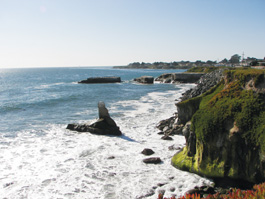home | metro santa cruz index | the arts | books | profile

In flux: Fragmented jetties along West Cliff show the power that constant waves can have on our eroding coast.
The Consistency of Change
UCSC professor explores history of Santa Cruz coast
By Steve Hahn
A runner jogging West Cliff trail might not give a passing thought to the shifting rock under her feet. Home-builders, enticed by the hefty profits high property values allow, build dangerously close to eroding cliffs. Many homeowners frequently dismiss the inherent risks associated with an oceanfront view. Worried over the pervasive lack of awareness about local coastal erosion, Gary Griggs, a professor in UCSC's earth science department, compiled photographs of the Santa Cruz coast over time, reasoning that some people need to see to believe.
Griggs has studied the coast for 35 years and recently released his book, Santa Cruz Coast: Then and Now, co-written by architect Deepika Shrenstha Ross (Arcadia Publishing; 96 pages; $19.99). Griggs gives an overview of the complicated processes that cause coastal change. The book juxtaposes photographs of the coast from the past and the present and includes captions featuring shreds of Griggs' encyclopedic knowledge of the area's natural and social history.
"I think the message is probably that the coast has been retreating--it's been retreating for about 18,000 years since the sea level began to rise after the last ice age, and all evidence suggests that's going to continue to happen," he says.
The book features photographs from the past provided by local historians, UCSC librarians, the Santa Cruz library, the Natural History Museum and various other sources constrasted with photos taken by Griggs and Ross in the exact same spot today.
Griggs intended for the book to be a more accessible cousin to another of his books, Living With the Changing California Coast (UC Press), which gives an exhaustive, 500-page review of the geology, sea walls and erosion hazards of the Santa Cruz coast.
While the pictures and captions in Santa Cruz Coast: Then and Now, mainly focus on the changes to the coast's geological structure, the shifting nature of the people who live near the coast is often interwoven into the narrative. Conservative, Victorian-era clothing is contrasted with today's less modest apparel. One image features a lone horse and buggy, while only a few pages later a stream of SUVs clog West Cliff Drive. The oldest photos reach 120 years into the past, but some of the contrasting images are only a couple of decades apart.
In many of the pictures where you see the culture and customs of those living next to the cliff change, you also notice an expansion of the society outward toward the cliff.
"If you look at the history of the development of Santa Cruz, if you look out on West Cliff or Opal Cliff, none of the early houses were close to the cliff," Griggs reminds us. "Property values weren't as high, people were more tuned into natural processes. But now property values have gotten so high it's tempting to build close to the cliff even if it's not going to be sustainable."
While Griggs emphasizes change and flux in nature, he is careful not to overgeneralize and includes numerous examples of places where the coast is nearly identical to its image from decades ago. Griggs hopes these differences in erosion along the coast will raise questions in the reader's mind and lead to a deeper exploration of how coastal erosion works. "It's really sort of a study in contrast," he says. "Some things are really eroding, and others not so fast, which means you pick carefully about where you build."
The stories told by the photos range from the history of the Boardwalk to tales of Santa Cruz's early fishing and cement industries, adding an interesting dimension to the book that keeps you engaged well after you've grasped the book's message.
"I think there's this perception that [coastal erosion] is an act of God, that it's only going to occur once in a lifetime," he says. "This book is trying to foster an appreciation of what goes on with the coast. Maybe people will look a little more carefully and notice things they didn't before."
Gary Griggs and Deepika Shrenstha Ross will give a short talk, answer questions and sign copies Tuesday, Nov. 7, at Santa Cruz Public Library, 224 Church St. (831.420.5700); and Thursday, Nov. 9, at Seymour Marine Discovery Center, 100 Shaffer Road, Santa Cruz (831.459.3800).
Send a letter to the editor about this story.
|
|
|
|
|
|